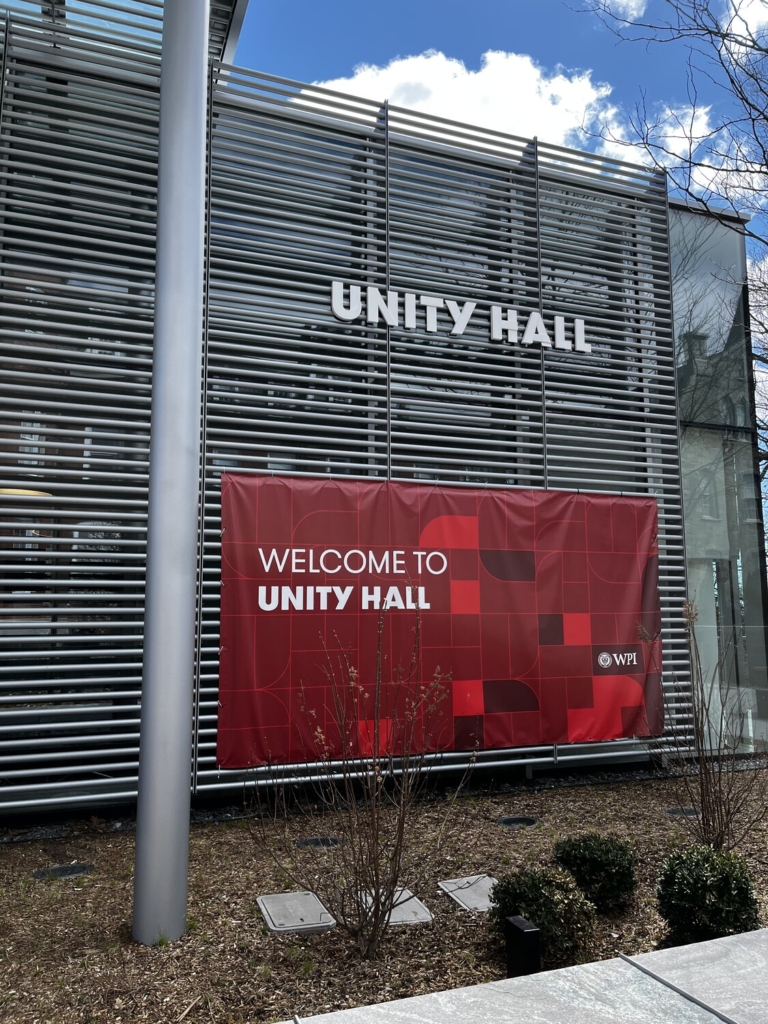WPI incorporates project-based learning

Worcester Polytechnic Institute
Karen A. Hott, June 2022
I visited WPI in April and attended an IECA webinar with Patrick Deane of WPI in June. On campus, the deep-red brick buildings are punctuated by newer ones, like the recreation center and Unity Hall, a shiny new building that connects the upper and lower parts of this hilly campus. Unity Hall brings together multiple student academic services in one place and provides spaces for interdisciplinary collaboration.

Progressive Curriculum
WPI’s curriculum is progressive on many levels. First, they employ a non-punitive grading system of A, B, C or No Record. To encourage collaboration, WPI doesn’t have pluses or minuses (like A-/B+). Second, there are no required courses, only recommended ones: In their flexible curriculum, “We advise; you decide.” Third, they have four seven-week terms, A through D, with an optional E term in June and July. This set-up allows students to achieve “More in Four.” Most importantly, the WPI Plan is a project-based curriculum.
WPI’s motto in German is “Lehr und Kunst,” which translates to “learning and skilled arts,” or theory and practice. Learn the theory and apply it to a practical problem. Working on a project requires creative problem-solving, time management, cooperation, communication, and more, skills needed when you enter the “real world” of your career. [I’m a big fan of project-based learning. As newspaper adviser in my teaching days, I saw so much growth in my newspaper students as they worked monthly to produce the newspaper.]
The WPI Plan
Students engage in an IQP, or Interactive Qualifying Project, as part of the WPI Plan, so that they work in interdisciplinary teams to solve a problem “at the intersection of science and society.” The interdisciplinary teams allow students to see how different STEM fields interact in the real world (www.wpi.edu/academics/undergraduate/interactive-qualifying-project). The senior capstone research project is called the MQP, or Major Qualifying Project, often sponsored by a corporation or government agency and leading to post-graduate employment.
Look carefully at the picture below. You can see a garage beneath the green field and brick wall. This was someone’s MQP. WPI needed a baseball field, but didn’t have a place to put it. The student had the idea to place the field atop the parking garage, which meant interdisciplinary problem-solving. It’s an example of the project-based curriculum addressing real problems.

This year, computer science was the top major, but WPI has 12 different engineering majors, from aerospace to architectural to mechanical to robotics. For engineering majors, business is a popular minor. When you apply to Worcester Polytechnic Institute, you apply to WPI as a whole, not a particular college or major. They don’t cap any programs. Part of the WPI Plan is a Humanities & Arts requirement, and this tech school has a large Humanities & Arts department with plenty of opportunity for creative expression.
Applying to WPI
WPI has been test blind since 2021 and was test optional before that. (Test-optional admissions means you can choose whether to submit scores or not. Test-blind admissions means they won’t look at your SAT or ACT scores even if you want them to.) WPI doesn’t require an application fee and is need blind. Application reviews are holistic. Your transcript is the best predictor of success. For financial aid, you’ll need to complete the FAFSA and the CSS Profile.
Who’s a good fit for WPI?
What kind of student is WPI looking for? People who are creative and curious, who enjoy working in teams, who love math and science but are passionate about more, who want to chart their own course and make the world better are students who belong at Worcester Polytechnic Institute.